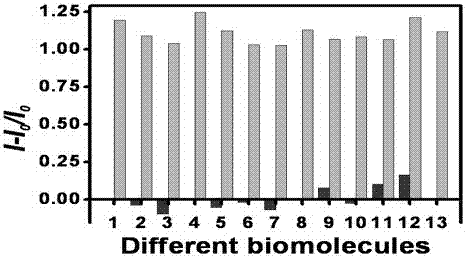Xanthone Schiff base modified graphene quantum dots CPCG as well as preparation method thereof and application in preparing sodium glutamate detection reagent
A technology of xanthone Schiff base and graphene quantum dots, which is applied in the preparation of sugar derivatives, chemical instruments and methods, sugar derivatives, etc., can solve the problems of slow development, complex synthesis methods, and low solubility of compounds , to achieve the effect of convenient operation, simple synthesis method and high selectivity
- Summary
- Abstract
- Description
- Claims
- Application Information
AI Technical Summary
Problems solved by technology
Method used
Image
Examples
Embodiment 1
[0020] Synthesis of Xanthone Schiff Base (abbreviation: CP)
[0021] (1) Place 1 g of chitosan (viscosity 100-200 mPa.s) in 100 mL aqueous solution containing 1% acetic acid, stir at a constant speed for 24 hours, then transfer the solution to a three-necked bottle, drop by drop Add 100 mL of ethanol solution containing 0.3 g of 1-chloro-4-propoxythioxanth-9-one, and then add 3 mL of glacial acetic acid dropwise, and heat and stir the mixture at 70 ºC for 20 h, stop stirring, and cool After reaching room temperature, neutralize with NaOH solution until the solution becomes neutral, filter, wash, and dry to obtain compound CP.
[0022] (2) Place 1.5 g of chitosan (viscosity 100-200 mPa.s) in 100 mL aqueous solution containing 5% acetic acid, stir at a constant speed for 12 hours, transfer the solution to a three-necked bottle, drop by drop Add 150 mL of ethanol solution containing 0.1 g of 1-chloro-4-propoxythioxanth-9-one, and then add 2 mL of glacial acetic acid dropwise, an...
Embodiment 2
[0024] Synthesis of compound CPCG
[0025] (1) Put 0.1 g of compound CP in 100 mL of acetic acid aqueous solution with a pH of 6, and stir until it is uniformly dispersed. Take 30 mL of 2.0 mg / mL graphene quantum dot aqueous solution in a 100 mL beaker, add 0.1 mL of N-hydroxysuccinimide and 1-(3-dimethylaminopropyl)-3-ethyl The mixed solvent of carbodiimide hydrochloride was used as a catalyst. After standing still for 10 minutes for activation, the above-mentioned uniformly dispersed CP solution was added dropwise, heated in a water bath at 40°C for 10 minutes with ultrasonic waves, heated in a water bath at 55°C for 5 hours, and then kept away from room temperature. After light stirring for 24 hours, the product was placed in a dialysis bag with a molecular weight of 1000 and dialyzed in 1000 mL deionized water for three days, and the water was changed every 3 hours to obtain the xanthone Schiff used for the detection of sodium glutamate Alkali-modified graphene quantum do...
Embodiment 3
[0027] Embodiment 3 (selective experiment)
[0028] In the fluorescence experiment, the compound CPCG was made into a 0.03 mg / mL aqueous stock solution. Glycine, glucose, glucosamine, sodium glutamate, maltose, lactose, sucrose, fructose and other substances were used as biomolecules. All experimental solutions were newly configured. And experiment now. Emitting at 426 nm, the biomolecules were tested separately. In the experiment, 2.5 mL of stock solution was taken, and 1M biomolecules solution was added respectively. Test its fluorescence spectrum.
PUM
| Property | Measurement | Unit |
|---|---|---|
| Viscosity | aaaaa | aaaaa |
Abstract
Description
Claims
Application Information
 Login to View More
Login to View More - R&D
- Intellectual Property
- Life Sciences
- Materials
- Tech Scout
- Unparalleled Data Quality
- Higher Quality Content
- 60% Fewer Hallucinations
Browse by: Latest US Patents, China's latest patents, Technical Efficacy Thesaurus, Application Domain, Technology Topic, Popular Technical Reports.
© 2025 PatSnap. All rights reserved.Legal|Privacy policy|Modern Slavery Act Transparency Statement|Sitemap|About US| Contact US: help@patsnap.com


